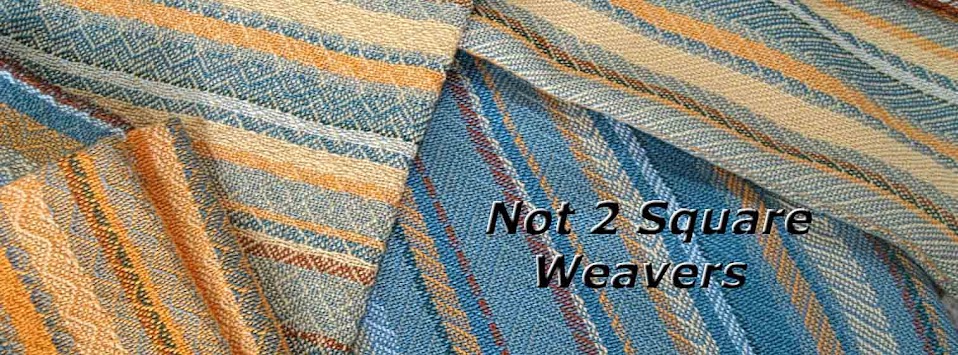You don't need a challenge for a weaver to want to "shake things up". What follows are interpretations of the same threading draft and the weaver's comments about their take on the challenge. As expected, no two experiments are the same.
I've taken some of the text posted on the display board from the fair and added a few thoughts of my own.
The Basics of Weaving
The patterns for weaving come from three components: the threading, tie-up and treadling. Any combination of those three items will affect the outcome of the woven item. In each example, the threading was kept the same or enlarged for the project, but the tie up and sometimes the treadling was changed. In the five works, see if you can pick out what is the same and what is different.
Mardi Naythons
Since this was the first time that I worked with advancing and point twill together, I decided to use the original threading as noted. It is a smaller sample because of that. It has only 396 threads. The treadling is tromp-as-writ. The one thing that I did do to make it somewhat mine was to make an ice dyed warp in sections. I tried to make the outer areas the same and I jogged the middle section in the dye bath so that it would be different.
Ingrid Knox
I took the original threading and extended it to the width I needed for a towel. I created two different random stripe patterns for the two areas with different threading designs. The tie-up is a 1-1-1-1-2-2 pattern. This towel used a tromp-as-writ treadling – that means I used treadles that mirrored the threading. The towel was woven using 10/2 cotton for the warp and weft. The sett is 30 epi.
Jeanne Doty
There were so many weaving possibilities in this weaving draft. Beryl Moody provided us with 37 different tie ups. Since it was difficult to choose just one, I chose 5 and made a scarf instead of 5 towels. It was fun to see these different drafts right next to each other. The warp was maroon 8/2 tencel with a lemon green 8/2 tencel weft. Each draft made changes to the color play, some bringing the warp color forward while another draft would bring the weft color forward.
Wendy-Marie Teichert
What was fun about this project was seeing how much variety could be achieved simply by changing the tie-up. I experimented with different weft colors – light purple, light yellow, blue and rose – to contrast with the dark purple warp. In retrospect, I think the weavings would have been more successful if I’d kept the weft color constant and varied the warp colors instead.
Beryl Moody
Weavers are always looking for a way to express their own ideas in the items they choose to weave. This weaving draft was ripe for an adventure. Having woven it nineteen years ago in a rather straightforward manner, I was thinking about what changes I could make this time around.
I decided that if I were to alternate colors in certain sections of the warp and then weave that warp with alternating colors this could change the appearance of the final textile, yet have it retain some of the original design. This method (in weaver's vernacular) is called color-and-weave. Where there are alternating color changes they tend to obscure the original design and give you something with an entirely new look. The towel I wove is a combination of the original draft showing through, along with sections of color interplay that distort that original pattern.
Here is a photo of one of the original towels woven 19 years ago. It is tromp-as-writ and resembles a ripe banana - thus the addition of the fruit!















